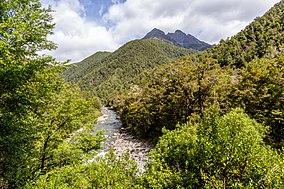| Kahurangi National Park | |
|---|---|
 View towards Mt Patriarch, Wangapeka Track | |
 Interactive map of Kahurangi National Park | |
| Nearest town | Tākaka |
| Coordinates | 41°15′S 172°7′E / 41.250°S 172.117°E |
| Area | 5,193 km2 (2,005 sq mi) |
| Established | 1996 |
| Governing body | Department of Conservation |
Kahurangi National Park is a national park in the northwest of the South Island of New Zealand. It is the second largest of the thirteen national parks of New Zealand. It was gazetted in 1996 and covers 5,193 km2 (2,005 sq mi), ranging from the Buller River near Murchison in the south, to the base of Farewell Spit in Golden Bay in the north. The park has no single dominant landform, but includes an unusually wide variety of landscapes, including mountain ranges, rivers, gorges, raised peneplains and karst features such as caves and arches. Many of the landforms within the park are considered to be nationally or internationally significant.
Its geology is complex, and is the most diverse of any of New Zealand's protected areas. It includes the best sequence of palaezoic rocks in the country. The complexity of these rock formations suggest that they result from the collision of three former continents. Kahurangi National Park also contains 80% of all New Zealand's alpine species. It also contains around 18 endemic bird species.
The park includes the Heaphy Track, a popular tramping and mountain biking track that is classified as one of New Zealand's Great Walks. Another multi-day tramping track in the park is the Wangapeka Track. In addition to tramping, rafting and caving are popular activities. Several locations in the national park were used during the making of the Lord of the Rings film series.
The park is managed by the Department of Conservation. Much of what was the north-west Nelson Forest Park formed the basis of the new park. Kahurangi Point, regarded as the boundary between the West Coast and Tasman Regions, is located in the park, as is Mount Owen.